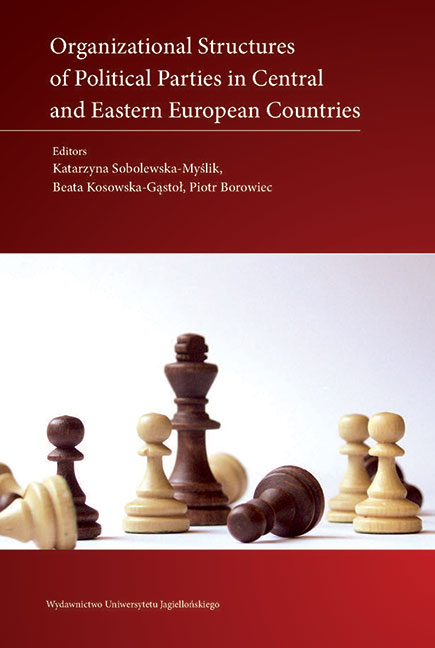Book contents
- Frontmatter
- Contents
- Preface
- Developing Party Structures in Central and Eastern Europe
- Albania: Organizations of Political Parties in Albania
- Belarus: Belarusian Political Parties: Organizational Structures and Practices
- Bosnia and Herzegovina: Organizational Structures of Political Parties in CEE Countries: A Case Study on Bosnia and Herzegovina
- Bulgaria: Organizational Structure and Trends in Bulgarian Party Politics
- Croatia: Organizational Structures of Political Parties in Croatia
- Czech Republic: Between Organizational Extremes: Czech Parties after a Political Earthquake
- Estonia: Organizational Structures of Political Parties in Estonia
- Hungary: Cut from the Same Cloth? A Comparative Analysis of Party Organizations in Hungary
- Kosovo: Structure of the Main Political Parties in Kosovo
- Latvia: Leader-Centered and Power-Hungry: Party Organizations in Latvia
- Lithuania: Organization of Political Parties: The Case of Lithuania
- Moldova: Organizational Structures of Political Parties in The Republic of Moldova
- Montenegro: Party Organization in Montenegro: Structural Resemblance Behind Political Divergence
- Poland: Structures of Polish Political Parties in the Second Decade of the 21st Century
- Romania: The Internal Organization of Romanian Political Parties
- Russia: Parties with Roots Growing Upwards: Organizational Features of Russian Political Parties
- Serbia: Organizational Structures of Political Parties in Serbia
- Slovakia: Organizational Structures of Political Parties in Slovakia: Parties not for Members
- Slovenia: Almost without Any Innovations: Organizational Structures in Slovenian Parties
- Ukraine: Shallow Party Structures in a Volatile Party System
- Comparing Organizational Structures of Political Parties in Central and Eastern European Countries
- Biographical notes about the authors
Comparing Organizational Structures of Political Parties in Central and Eastern European Countries
- Frontmatter
- Contents
- Preface
- Developing Party Structures in Central and Eastern Europe
- Albania: Organizations of Political Parties in Albania
- Belarus: Belarusian Political Parties: Organizational Structures and Practices
- Bosnia and Herzegovina: Organizational Structures of Political Parties in CEE Countries: A Case Study on Bosnia and Herzegovina
- Bulgaria: Organizational Structure and Trends in Bulgarian Party Politics
- Croatia: Organizational Structures of Political Parties in Croatia
- Czech Republic: Between Organizational Extremes: Czech Parties after a Political Earthquake
- Estonia: Organizational Structures of Political Parties in Estonia
- Hungary: Cut from the Same Cloth? A Comparative Analysis of Party Organizations in Hungary
- Kosovo: Structure of the Main Political Parties in Kosovo
- Latvia: Leader-Centered and Power-Hungry: Party Organizations in Latvia
- Lithuania: Organization of Political Parties: The Case of Lithuania
- Moldova: Organizational Structures of Political Parties in The Republic of Moldova
- Montenegro: Party Organization in Montenegro: Structural Resemblance Behind Political Divergence
- Poland: Structures of Polish Political Parties in the Second Decade of the 21st Century
- Romania: The Internal Organization of Romanian Political Parties
- Russia: Parties with Roots Growing Upwards: Organizational Features of Russian Political Parties
- Serbia: Organizational Structures of Political Parties in Serbia
- Slovakia: Organizational Structures of Political Parties in Slovakia: Parties not for Members
- Slovenia: Almost without Any Innovations: Organizational Structures in Slovenian Parties
- Ukraine: Shallow Party Structures in a Volatile Party System
- Comparing Organizational Structures of Political Parties in Central and Eastern European Countries
- Biographical notes about the authors
Summary
Some Determinants of Political Party Development in Emerging Democracies of CEE
Democratic political parties have developed in the emerging democracies of Central and Eastern Europe (CEE) since the beginning of the 1990s, when political parties in well-established democracies were undergoing organizational transformation. The latter weakened their ties with society and strengthened their relations with the state using its resources. This influenced the development of parties in CEE countries, as they followed Western patterns to a certain degree. But whereas parties in developed democracies were usually well-rooted in society, represented social cleavages, had mass membership, were financed by membership fees, and changed only subsequently; parties in CEE did not manage to create strong relations with society before they took part in elections. There was a lack of clear social cleavages, and parties were created by political elites rather than social groups or movements, thus they oft en became a part of the state institutions even before they tried to establish roots in society.1 While in Western Europe mass political mobilization preceded the building of party structures and participation inelections, “party formation in newly established democracies generally followed a different trajectory, as parties engaged in mass electoral competition before developing their party organization” (van Biezen 2003: 30). Consequently, such parties gained representation in parliament, and sometimes even executive power, before creating extra-parliamentary organizations. This clearly weakened their structures to a large degree.
Also important here is that parties from CEE countries have undergone some changes similar to their counterparts in Western Europe in terms of mediatization, personalization, and prezidentialization of party politics (Poguntke and Webb 2005). In well-developed democracies, these processes have altered the mechanisms of political communication, and strengthened the positions of party leaders at the expense of other party structures. In Central and Eastern European countries, such changes had occurred before the organizational structures of political parties were fully formed, thus their effects were even stronger, and the power of party leaders in relation to other party bodies has become very significant. Th fact that some parties have not experienced alternation of leadership, and are still governed by their “founding fathers” is an additional incentive to strengthen the power of party chairmen. These parties are oft en perceived as “the property of the founder.”
- Type
- Chapter
- Information
- Organizational Structures of Political Parties in Central and Eastern European Countries , pp. 465 - 484Publisher: Jagiellonian University PressPrint publication year: 2017



